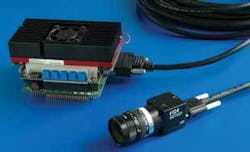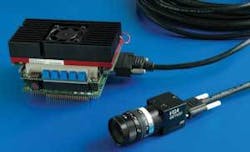Power-over-Camera-Link products emerge
Andrew Wilson, Editor, [email protected]
Despite lack of final ratification from the Camera Link committee of the Automated Imaging Association (AIA: Ann Arbor, MI, USA; www.machinevisiononline.org), the promise of Power-over-Camera-Link (PoCL) took a step forward at the 2006 Vision Show East (Boston, MA, USA; May 9-11). There, a number of companies showed working cameras and frame grabbers while others promised support for the standard once approved.
In the original 26-pin Camera Link design, pins 1, 13, 14, and 26 were assigned as ground. To maintain backward compatibility with this connector, pins 1 and 26 are reassigned as power lines that deliver up to 333 mA at 12 V, or 400 mA at the lowest allowable 10 V, according to Steve Kinney of JAI (Glostrup, Denmark; www.jai.com; see Vision Systems Design, Feb. 2006, p. 23).
However, because supplying power from the frame grabber to a noncompatible Camera Link camera results in shorting of the power in the camera, camera vendors need to place a parallel 10k-Ω resistor between the power and ground lines. Similarly, frame-grabber vendors must provide camera power and a sensing mechanism to measure the impedance across the four pins.
“This,” says Chris Beynon, technical director of Active Silicon (Uxbridge, UK; www.activesilicon.co.uk), “is what we are currently calling the Camera Link SafePower mode. But while the 4 W of power available will allow cameras to be powered from PC-based frame grabbers, high-performance cameras will still require external power supplies.” While the SafePower concept will be supported on both the MDR-26 and the latest mini-Camera Link connectors, many believed that the smaller connector would find most favor among camera and frame-grabber vendors.
An initial pioneer of both, CIS (Tokyo, Japan; www.ciscorp.co.jp) demonstrated a number of small CCD-based cameras including its monochrome 60-frame/s G21 VGA that uses the mini-CL connector and supports the SafePower standard. According to Yusuke Muraoka, general manager of corporate planning, several other members of the Japanese Industrial Imaging Association, including Hitachi and Toshiba, have similar products under development.
Muraoka discussed the frame-grabber support currently available for its CCD camera range. According to Muraoka, Micro-Technica (Tokyo, Japan; www.microtechnica.co.jp), First (Machida; Japan), Active Silicon, and dPict Imaging (Indianapolis, IN, USA; www.dpictimaging.com) all offer frame grabbers that allow power to be supplied directly through the Camera Link connector.
At the show, CIS showed a working demonstration of the G21 camera interfaced to dPict Imaging’s PCI-based Nexeon frame grabber. According to Brian Pinto, director of sales at dPict, the board provides an interface to Camera Link cameras with a Base configuration running at pixel clock rates up to 80 MHz and supports both RGB and monochrome cameras at 8/10/12/14/16/24-bit depths at these rates.
dPict was not the only vendor supporting PoCL at the show. Pinto said that dPict is well aware of the problems of supplying power to noncompatible Camera Link cameras and stands ready to fully support and implement the standard once ratified by the AIA Camera Link committee. “We are pleased with PoCL as a small step forward in turning Camera Link into a plug-and-play standard,” he says.
Active Silicon also showed a modified version of its PHX-D24CL PCI-based frame grabber designed to capture images from Base Camera Link PoCL cameras using the SafePower protocol. “By modifying each board as it is upgraded,” says Active Silicon’s Beynon, “Active Silicon will support the SafePower standard across its range of Camera Link frame grabbers.” Other vendors also plan on supporting the standard.
According to Manuel Romero, OEM application interface specialist with DALSA (Waterloo, ON, Canada; www.dalsa.com), the company will introduce PoCL for its range of X-64 Camera Link frame grabbers later this year.
Despite the numerous benefits of using standardized connectors and a high-speed point-to-point interface, for some, the maximum 850-Mbyte/s data-transfer rate of Camera Link (at 85 MHz) is not fast enough. According to Romero, the AIA Camera Link committee is aware of this and is currently studying alternatives for a next-generation camera interface. Whether this includes support for the PCI Express standard remains to be seen.

